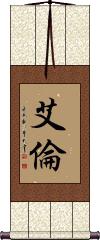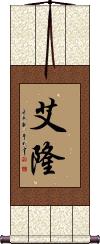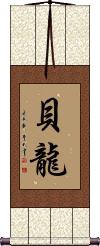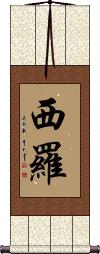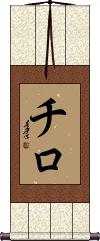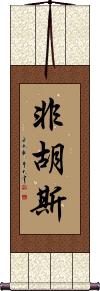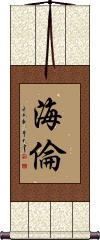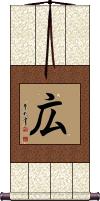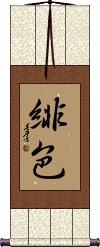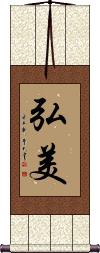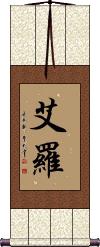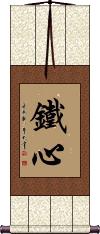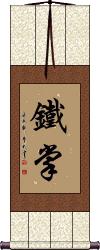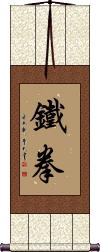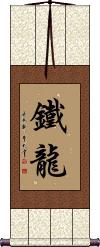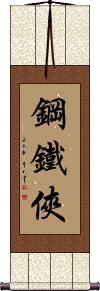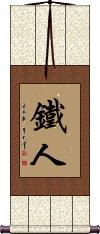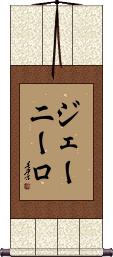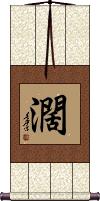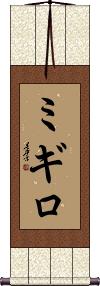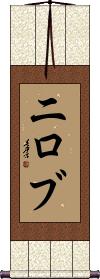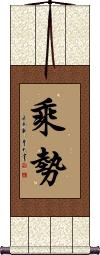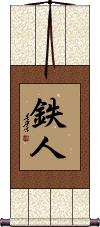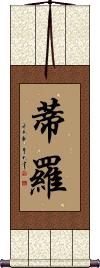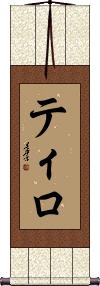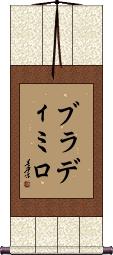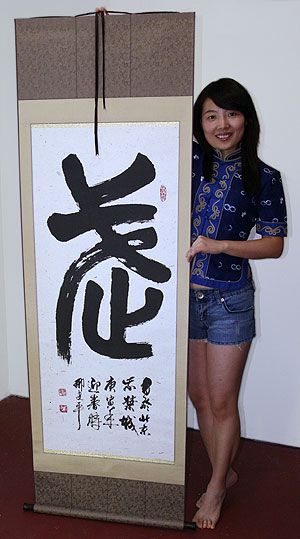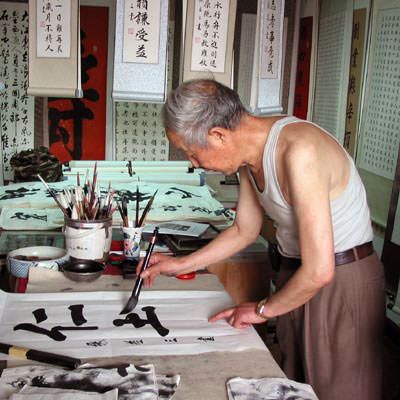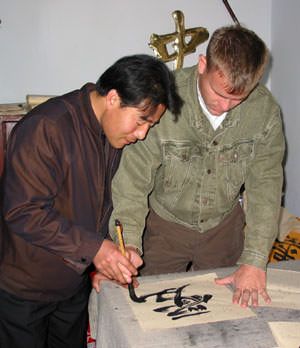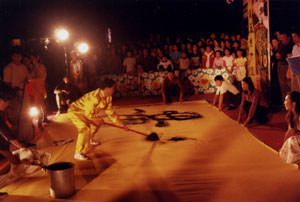The Name Iro in Japanese/Chinese on a Custom-Made Wall Scroll.
Click the "Customize" button next to your name below to start your personalized iro calligraphy artwork...
Switched to secondary search mode due to lack of results using primary.
These secondary results may not be very accurate. Try a different but similar meaning word or phrase for better results. Or...
Look up Iro in my Japanese Kanji & Chinese Character Dictionary(My dictionary is a different system then the calligraphy search you just tried)
If you want a special phrase, word, title, name, or proverb, feel free to contact me, and I will translate your custom calligraphy idea for you.
1. Airon
2. Airone
3. Amiro
4. Bairon
5. Casimiro
6. Ciro
7. Cordeiro
8. Fairouz
9. Girod
10. Guerreiro
11. Hairon
12. Hiro
13. Hiromy
14. Ichiro
15. Ikiro
16. Iro
17. Iron Heart
18. Iron Palm
19. Iron Fist
20. Iron Dragon
21. Iron Man
23. Janeiro
24. Kairon
25. Hiroshi / Katsu
26. Liroye
27. Migiro
28. Mimiro
29. Miron
30. Miroslav
31. Miroslaw
32. Nairobi
33. Nairoby
34. Nirob
35. Even an iron bar can be ground to a needle
36. Pineiro
37. Quiroga
38. Quiroz
39. Ramiro
40. Ribeiro
41. Rimiro
42. Shapiro
43. Shirona
44. Sirois
45. Spiros
46. Strike While the Iron is Hot
47. Tanjiro Kamado
48. Iron Man
49. Tiro
50. Tiroca
51. Ueshiro Shorin-Ryu / Ueshiro Matsubayashi-Ryu
52. Vairochana
53. Vidiro
54. Vladimiro
Airon
Airon
Airone
Airone
Amiro
Amiro
Bairon
Bairon
Casimiro
Casimiro
Ciro
Ciro
Cordeiro
Cordeiro
Fairouz
Fairouz
Girod
Girod
Guerreiro
Guerreiro
Hairon
Hairon
Hiro
広 is the Japanese variant of 廣 (from Chinese).
The original meaning is wide, numerous, or to spread out. However, in modern Japan, this is used primarily as a given name. Most often it is romanized as Hiro.
This Kanji can also romanize as the names Yutaka, Hiromu, Hiromatsu, Hirotsugu, Hirosue, Hiroji, Hiroshi, Hirosaki, Hirokatsu, Kouji, or Kou.
In Chinese, this would romanize as guǎng where it still holds the original meaning and is a common Chinese surname. However, this 広 version is strictly Japanese, and most Chinese will not realize it’s a variant of 廣. This will be true especially in the mainland where the Simplified Chinese is now written as 广.
Hiro
Hiromy
Hiromy
Ichiro
Ikiro
Iron Heart
鐵心 can be translated as “iron heart,” “steel core,” or “iron mind” in Chinese and Japanese Kanji.
This is not a common term, but I added it here since so many were looking for “iron heart.” This is almost like saying you are without emotions or feelings - a very stoic person. This is not a Buddhist trait.
Iron Palm
鐵掌 means “iron palm,” the martial arts technique taught by Brian Gray and others.
This term can mean different things to different people. The consensus is that rather than a type or style of martial arts, this is a technique for refining hand position and strengthening hands to strike blows with maximum force and effect.
The regime may include herbal treatments and special exercises to fortify the hands.
In more extreme versions, the carpals and metacarpal bones in the hand are systematically broken so that when they heal, they will become stronger.
Japanese note: This does make sense in Japanese (though the version shown above is the ancient form of the first Kanji), this is far from a commonly-known term.
Iron Fist
Tie Quan / Tieh Chuan
鐵拳 is a common theme used by various schools of martial arts.
鐵 means “iron” but, in some cases, can mean “indisputable.”
拳 means fist.
Some schools use the older/Taiwanese way to Romanize the iron fist, so you may have seen it spelled “Tieh Chuan” instead of “Tie Quan.” Neither way is technically incorrect.
Note that in Mandarin, the first part of the first character sounds like the English word “tea,” blending into a soft “-eh” sound. The second character sounds a lot like “chew on” but as if it is one syllable.
![]() After WWII in Japan, the Kanji for iron was simplified. This new Kanji form is shown to the right. If you want this modern Japanese version, please click on the Kanji to the right, instead of the button above. The characters shown to the left would still be considered the old or ancient Japanese version of this title.
After WWII in Japan, the Kanji for iron was simplified. This new Kanji form is shown to the right. If you want this modern Japanese version, please click on the Kanji to the right, instead of the button above. The characters shown to the left would still be considered the old or ancient Japanese version of this title.
Iron Dragon
Iron Man
Ironman Triathlon Event
Janeiro
Kairon
Kairon
Hiroshi / Katsu
Liroye
Liroye
Migiro
Migiro
Mimiro
Mimiro
Miron
Miron
Miroslav
Miroslav
Miroslaw
Miroslaw
Nairobi
Nairobi
Nairoby
Nairoby
Nirob
Nirob
Even an iron bar can be ground to a needle
Pineiro
Pineiro
Quiroga
Quiroga
Quiroz
Quiroz
Ramiro
Ramiro
Ribeiro
Ribeiro
Rimiro
Rimiro
Shapiro
Shapiro
Shirona
Shirona
Sirois
Sirois
Spiros
Spiros
Strike While the Iron is Hot
Tanjiro Kamado
Iron Man
Tiro
Tiro
Tiroca
Tiroca
Ueshiro Shorin-Ryu / Ueshiro Matsubayashi-Ryu
ウエシロ鬆林流 is the title Ueshiro Shorin-Ryu or Ueshiro Matsubayashi-Ryu in Japanese Katakana and Kanji.
Ueshiro's name is Okinawan, so there is no standard Japanese Kanji transliteration; therefore, a Katakana version (ウエシロ) is appropriate.
松林 can be romanized/pronounced as shorin or matsubayashi thus the two title variations.
Note: Because this selection contains some special Japanese Katakana characters, it should be written by a Japanese calligrapher.
Vairochana
Vairochana
Vidiro
Vidiro
Vladimiro
Vladimiro
Stay Strong / Iron Will
鉄心石腸 is a Japanese proverb that suggests you should have the inner-strength and will as hard and steadfast as iron.
It's the Japanese way of saying, “stay strong.” This is an especially uplifting thing to say to a person in distress or recovering from a disaster. It's kind of the survivor's creed.
If you literally translate this, it means “iron will, stone guts” or “iron heart, rock-hard bowels.”
The following table may be helpful for those studying Chinese or Japanese...
| Title | Characters | Romaji (Romanized Japanese) | Various forms of Romanized Chinese | |
| Airon | 艾倫 艾伦 | ài lún / ai4 lun2 / ai lun / ailun | ||
| Airon | アイロン | airon | ||
| Airone | 艾隆 | ài lóng / ai4 long2 / ai long / ailong | ai lung / ailung | |
| Airone | アイロン | airon | ||
| Amiro | 阿米羅 阿米罗 | ā mǐ luó a1 mi3 luo2 a mi luo amiluo | a mi lo amilo |
|
| Amiro | アミロ | amiro | ||
| Bairon | 貝龍 贝龙 | bèi lóng / bei4 long2 / bei long / beilong | pei lung / peilung | |
| Bairon | バイロン | bairon | ||
| Casimiro | 卡西米羅 卡西米罗 | kǎ xī mǐ luó ka3 xi1 mi3 luo2 ka xi mi luo kaximiluo | k`a hsi mi lo kahsimilo ka hsi mi lo |
|
| Casimiro | カシミロ | kashimiro | ||
| Ciro | 西羅 西罗 | xī luó / xi1 luo2 / xi luo / xiluo | hsi lo / hsilo | |
| Ciro | チロ | chiro | ||
| Cordeiro | 科代羅 科代罗 | kē dài luó ke1 dai4 luo2 ke dai luo kedailuo | k`o tai lo kotailo ko tai lo |
|
| Cordeiro | コルデイロ | korudeiro | ||
| Fairouz | 非胡斯 | fēi hú sī fei1 hu2 si1 fei hu si feihusi | fei hu ssu feihussu |
|
| Fairouz | フェーロス | feerosu / ferosu | ||
| Girod | 吉羅德 吉罗德 | jí luó dé ji2 luo2 de2 ji luo de jiluode | chi lo te chilote |
|
| Girod | ジロッド | jiroddo | ||
| Guerreiro | 格雷羅 格雷罗 | gé léi luó ge2 lei2 luo2 ge lei luo geleiluo | ko lei lo koleilo |
|
| Guerreiro | ゲレイロ | gereiro | ||
| Hairon | 海倫 海伦 | hǎi lún / hai3 lun2 / hai lun / hailun | ||
| Hairon | ヘアロン | hearon | ||
| Hiro | 広 | hiro | guǎng / guang3 / guang | kuang |
| Hiro | 緋色 | hiro | ||
| Hiromy | 弘美 | hóng měi / hong2 mei3 / hong mei / hongmei | hung mei / hungmei | |
| Hiromy | ヒロミー | hiromii / hiromi | ||
| Ichiro | イチロー | ichiroo / ichiro | ||
| Ikiro | イキロ | ikiro | ||
| Iro | 艾羅 艾罗 | ài luó / ai4 luo2 / ai luo / ailuo | ai lo / ailo | |
| Iro | アイロ | airo | ||
| Iron Heart | 鐵心 铁心 | tetsu kokoro / tesshin tetsukokoro / tesshin tetsu kokoro / teshin | tiě xīn / tie3 xin1 / tie xin / tiexin | t`ieh hsin / tiehhsin / tieh hsin |
| Iron Palm | 鐵掌 铁掌 | tetsu-tenohira | tiě zhǎng tie3 zhang3 tie zhang tiezhang | t`ieh chang tiehchang tieh chang |
| Iron Fist | 鐵拳 铁拳 / 鉄拳 | tekken / teken | tiě quán / tie3 quan2 / tie quan / tiequan | t`ieh ch`üan / tiehchüan / tieh chüan |
| Iron Dragon | 鐵龍 铁龙 | tiě lóng / tie3 long2 / tie long / tielong | t`ieh lung / tiehlung / tieh lung | |
| Iron Man | 鋼鐵俠 | gāng tiě xiá gang1 tie3 xia2 gang tie xia gangtiexia | kang t`ieh hsia kangtiehhsia kang tieh hsia |
|
| Ironman Triathlon Event | 鐵人 铁人 | tetsu jin / tetsujin | tiě rén / tie3 ren2 / tie ren / tieren | t`ieh jen / tiehjen / tieh jen |
| Janeiro | ジェーニーロ | jeeniiro / jeniro | ||
| Kairon | 凱倫 凯伦 | kǎi lún / kai3 lun2 / kai lun / kailun | k`ai lun / kailun / kai lun | |
| Kairon | カイロン | kairon | ||
| Hiroshi Katsu | 濶 阔 | hiroshi / katsu | ||
| Liroye | 利羅依 利罗依 | lì luó yī li4 luo2 yi1 li luo yi liluoyi | li lo i liloi |
|
| Liroye | リロイ | riroi | ||
| Migiro | 米吉羅 米吉罗 | mǐ jí luó mi3 ji2 luo2 mi ji luo mijiluo | mi chi lo michilo |
|
| Migiro | ミギロ | migiro | ||
| Mimiro | 米米羅 米米罗 | mǐ mǐ luó mi3 mi3 luo2 mi mi luo mimiluo | mi mi lo mimilo |
|
| Mimiro | ミミロ | mimiro | ||
| Miron | 米隆 | mǐ lóng / mi3 long2 / mi long / milong | mi lung / milung | |
| Miron | ミロン | miron | ||
| Miroslav | 米羅斯拉夫 米罗斯拉夫 | mǐ luó sī lā fū mi3 luo2 si1 la1 fu1 mi luo si la fu miluosilafu | mi lo ssu la fu milossulafu |
|
| Miroslav | ミロスラフ | mirosurafu | ||
| Miroslaw | 米羅斯瓦夫 米罗斯瓦夫 | mǐ luó sī wǎ fū mi3 luo2 si1 wa3 fu1 mi luo si wa fu miluosiwafu | mi lo ssu wa fu milossuwafu |
|
| Miroslaw | ミロスロー | mirosuroo / mirosuro | ||
| Nairobi | 內羅畢 内罗毕 | nèi luó bì nei4 luo2 bi4 nei luo bi neiluobi | nei lo pi neilopi |
|
| Nairobi | ナイロビ | nairobi | ||
| Nairoby | 內羅比 内罗比 | nèi luó bǐ nei4 luo2 bi3 nei luo bi neiluobi | nei lo pi neilopi |
|
| Nairoby | ナイロビー | nairobii / nairobi | ||
| Nirob | 尼羅布 尼罗布 | nī luó bù ni1 luo2 bu4 ni luo bu niluobu | ni lo pu nilopu |
|
| Nirob | ニロブ | nirobu | ||
| Even an iron bar can be ground to a needle | 磨杵成針 磨杵成针 | mó chǔ chéng zhēn mo2 chu3 cheng2 zhen1 mo chu cheng zhen mochuchengzhen | mo ch`u ch`eng chen mochuchengchen mo chu cheng chen |
|
| Pineiro | 皮涅羅 皮涅罗 | pí niè luó pi2 nie4 luo2 pi nie luo pinieluo | p`i nieh lo piniehlo pi nieh lo |
|
| Pineiro | ピネイロ | pineiro | ||
| Quiroga | 奎羅加 奎罗加 | kuí luó jiā kui2 luo2 jia1 kui luo jia kuiluojia | k`uei lo chia kueilochia kuei lo chia |
|
| Quiroga | キロガ | kiroga | ||
| Quiroz | 奎羅斯 奎罗斯 | kuí luó sī kui2 luo2 si1 kui luo si kuiluosi | k`uei lo ssu kueilossu kuei lo ssu |
|
| Quiroz | キロズ | kirozu | ||
| Ramiro | 拉米羅 拉米罗 | lā mǐ luó la1 mi3 luo2 la mi luo lamiluo | la mi lo lamilo |
|
| Ramiro | ラミロ | ramiro | ||
| Ribeiro | 里貝羅 里贝罗 | lǐ bèi luó li3 bei4 luo2 li bei luo libeiluo | li pei lo lipeilo |
|
| Ribeiro | リベイロ | ribeiro | ||
| Rimiro | 里米羅 里米罗 | lǐ mǐ luó li3 mi3 luo2 li mi luo limiluo | li mi lo limilo |
|
| Rimiro | リミロ | rimiro | ||
| Shapiro | 沙皮羅 沙皮罗 | shā pí luó sha1 pi2 luo2 sha pi luo shapiluo | sha p`i lo shapilo sha pi lo |
|
| Shapiro | シャピロ | shapiro | ||
| Shirona | 希羅娜 希罗娜 | xī luó nà xi1 luo2 na4 xi luo na xiluona | hsi lo na hsilona |
|
| Shirona | シロナ | shirona | ||
| Sirois | 西羅伊斯 西罗伊斯 | xī luó yī sī xi1 luo2 yi1 si1 xi luo yi si xiluoyisi | hsi lo i ssu hsiloissu |
|
| Sirois | シロワ | shirowa | ||
| Spiros | 斯皮羅斯 斯皮罗斯 | sī pí luó sī si1 pi2 luo2 si1 si pi luo si sipiluosi | ssu p`i lo ssu ssupilossu ssu pi lo ssu |
|
| Spiros | スピロス | supirosu | ||
| Strike While the Iron is Hot | 乘勢 乘势 | chéng shì cheng2 shi4 cheng shi chengshi | ch`eng shih chengshih cheng shih |
|
| Tanjiro Kamado | 竈門炭治郎 | kamado tanjirou kamadotanjirou kamado tanjiro | ||
| Iron Man | 鉄人 | tetsujin | ||
| Tiro | 蒂羅 蒂罗 | dì luó / di4 luo2 / di luo / diluo | ti lo / tilo | |
| Tiro | ティロ | tiro | ||
| Tiroca | 蒂羅卡 蒂罗卡 | dì luó kǎ di4 luo2 ka3 di luo ka diluoka | ti lo k`a tiloka ti lo ka |
|
| Tiroca | ティロカ | tiroka | ||
| Ueshiro Shorin-Ryu Ueshiro Matsubayashi-Ryu | ウエシロ鬆林流 ウエシロ松林流 | u e shi ro matsu bayashi ryuu / u e shi ro shou rin ryuu u e shi ro matsu bayashi ryu / u e shi ro sho rin ryu | ||
| Vairochana | 瓦伊羅查納 瓦伊罗查纳 | wǎ yī luó chá nà wa3 yi1 luo2 cha2 na4 wa yi luo cha na wayiluochana | wa i lo ch`a na wailochana wa i lo cha na |
|
| Vairochana | ヴァイロチャナ | vairochana | ||
| Vidiro | 維迪羅 维迪罗 | wéi dí luó wei2 di2 luo2 wei di luo weidiluo | wei ti lo weitilo |
|
| Vidiro | ヴィディロ | vidiro | ||
| Vladimiro | 弗拉迪米羅 弗拉迪米罗 | fú lā dí mǐ luó fu2 la1 di2 mi3 luo2 fu la di mi luo fuladimiluo | fu la ti mi lo fulatimilo |
|
| Vladimiro | ブラディミロ | buradimiro | ||
| Stay Strong Iron Will | 鉄心石腸 | tesshin sekichou tesshinsekichou teshin sekicho | ||
| In some entries above you will see that characters have different versions above and below a line. In these cases, the characters above the line are Traditional Chinese, while the ones below are Simplified Chinese. | ||||
